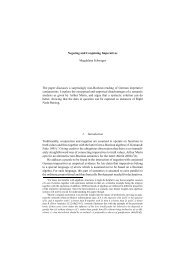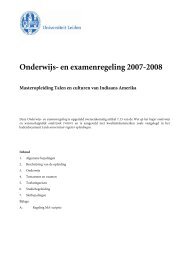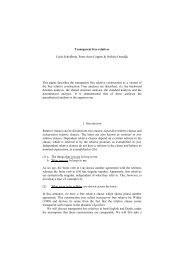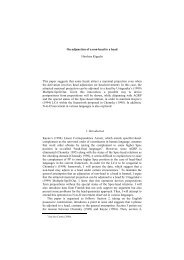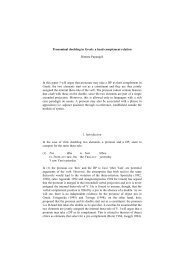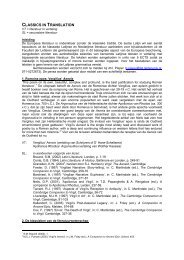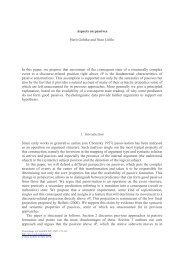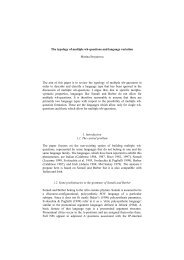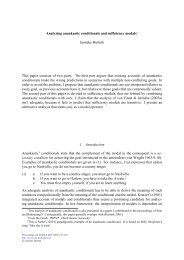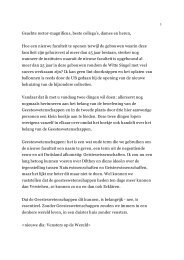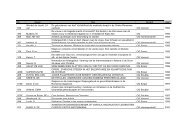Temporal anchoring of habituals J. Magdalena Scheiner I argue that ...
Temporal anchoring of habituals J. Magdalena Scheiner I argue that ...
Temporal anchoring of habituals J. Magdalena Scheiner I argue that ...
You also want an ePaper? Increase the reach of your titles
YUMPU automatically turns print PDFs into web optimized ePapers that Google loves.
<strong>Temporal</strong> <strong>anchoring</strong> <strong>of</strong> <strong>habituals</strong><br />
J. <strong>Magdalena</strong> <strong>Scheiner</strong><br />
I <strong>argue</strong> <strong>that</strong> so called ‘habitual sentences’ contain an extensional HAB-operator<br />
<strong>that</strong> is different from the generic operator. It locates points <strong>of</strong> time/intervals<br />
within a larger interval characterized by a habitus <strong>that</strong> is a cumulatively<br />
quantized property <strong>of</strong> times. HAB therefore acts as a stativizer, which accounts<br />
for the combination <strong>of</strong> habitualized predicates with certain adverbials and tense<br />
forms <strong>that</strong> require homogeneity <strong>of</strong> the predicates they combine with.<br />
Quantificational adverbs like <strong>of</strong>ten, rarely, etc. are not overt forms <strong>of</strong> HAB.<br />
Instead, they modify its complement yielding a habitus (frequentative reading)<br />
or, on a non-habitual reading, count events (iterative reading).<br />
1. Introduction<br />
The distinction between sentences dealing with single events or particular<br />
individuals and sentences presenting properties holding <strong>of</strong> typical instances <strong>of</strong><br />
kinds or events <strong>that</strong> happen regularly seems to be well attested<br />
crosslinguistically. The latter class is usually subsumed under the cover term <strong>of</strong><br />
genericity. Sentences <strong>that</strong> in the broadest sense deal with things <strong>that</strong> happen<br />
regularly are called <strong>habituals</strong>.<br />
Most <strong>of</strong> the literature dealing with <strong>habituals</strong> considers them as some special<br />
sort <strong>of</strong> generics, namely those <strong>that</strong> involve generic quantification not over<br />
individual variables, but over the situation variable provided by some eventive<br />
verb (Carlson & Pelletier 1995, Cohen 1999, Lenci & Bertinetto 2000).<br />
Following Carlson & Pelletier (1995) the proposed structures roughly look like<br />
the one in (1):<br />
(1) GEN s [...s...][...s....]<br />
It is claimed <strong>that</strong> there is a generic quantifier (here: GEN) which is somewhat<br />
similar to the universal quantifier but nevertheless differs from the latter in<br />
various important respects. This quantifier is claimed to resemble a Lewisian<br />
adverb <strong>of</strong> quantification (Lewis 1975) and therefore unselectively bind the free<br />
variables in the restrictor, be it <strong>that</strong> they run over situations (as indicated in (1))
2<br />
J. <strong>Magdalena</strong> <strong>Scheiner</strong><br />
or over individuals. So the claim is <strong>that</strong> to know how to analyse the generic<br />
operator when running over individuals is to know the right treatment for<br />
habitual sentences as well.<br />
However, a closer look at the structure in (1) shows <strong>that</strong> it cannot account<br />
for the temporal and aspectual properties exhibited by <strong>habituals</strong>. I will therefore<br />
follow the lines taken in Paslawska & von Stechow (2002) providing for an<br />
analysis <strong>that</strong> is able to integrate them in a framework which allows us to<br />
explain their behaviour in connection with temporal adverbials and certain<br />
tense aspect forms.<br />
2. Fencing <strong>of</strong>f <strong>habituals</strong><br />
When I have so far spoken <strong>of</strong> ‘<strong>habituals</strong>’ as referring to events <strong>that</strong> happen<br />
regularly I have concealed the fact <strong>that</strong> it is all but clear what has to count as a<br />
habitual. We are hardly ever provided with something like a definition when<br />
taking a look at the relevant literature.<br />
I will start out with the idea <strong>that</strong> we can count as <strong>habituals</strong> all those<br />
sentences <strong>that</strong> either already contain periphrases such as used to, has the habit<br />
<strong>of</strong> (and their respective translations to the languages in question) (cf. 2a), or can<br />
be modified with one <strong>of</strong> these without change in meaning (cf. 2b):<br />
(2) a. Marina used to drink c<strong>of</strong>fee.<br />
b. Sonja drinks tea.<br />
2.1. Habituals are not eventives<br />
Parting with this rough characterization we can now try to set them apart from<br />
other types <strong>of</strong> sentences.<br />
Quite a standard assumption is <strong>that</strong> they are to be kept apart from eventive<br />
sentences:<br />
(3) a. Volker is smoking a cigarette.<br />
b. Volker smokes cigarettes.<br />
While (3a) speaks about one particular event <strong>of</strong> Volker smoking a cigarette,<br />
(here implicitly) located in time and space, (3b) abstracts over many such<br />
events therefore presenting cigarette-smoking as a habit <strong>of</strong> Volker’s. At least in<br />
the present tense, English is quite explicit about this distinction, using either the<br />
Simple Present or the Present Continuous. Although only some dialects <strong>of</strong><br />
German (Rheinische Verlaufsform) provide us with such a distinction in the<br />
verbal paradigm, periphrases, adverbs or pragmatic considerations help to<br />
disambiguate the relevant readings in German.
<strong>Temporal</strong> <strong>anchoring</strong> <strong>of</strong> <strong>habituals</strong> 3<br />
2.2. Habituals are different from dispositions and rules<br />
In contrast to Carlson & Pelletier (1995) and Lenci & Bertinetto (2000) I will<br />
follow Cohen (1999) in assuming <strong>that</strong> <strong>habituals</strong> have to be set apart from<br />
modalized sentences as well. One such type <strong>of</strong> sentences <strong>that</strong> usually gets<br />
conflated with <strong>habituals</strong> is dispositions (cf. 4): 1<br />
(4) Dieses Auto geht 250 km/h.<br />
this car goes-PRESENT 250 kph<br />
‘This car makes 250 kph.’<br />
If (4) really were habitual it should not change its meaning when applied one <strong>of</strong><br />
the aforementioned periphrases:<br />
(5) a. This car has the habit <strong>of</strong> making 250kph.<br />
b. This car can make 250 kph.<br />
Considering the outcome it is rather the modal auxiliary can expressing<br />
circumstantial possibility (cf. 5b) than the habituality periphrasis (cf. 5a) <strong>that</strong><br />
renders the most prominent reading <strong>of</strong> (4) correctly (this is not to say <strong>that</strong> (4)<br />
can’t have the reading (5a) has – it’s just not the dispositional reading usually<br />
discussed when taking into account sentences like (4)). I therefore assume <strong>that</strong><br />
dispositional readings have to be kept apart from habitual readings.<br />
The same goes mutatis mutandis for constitutive rules as exemplified in<br />
(6):<br />
(6) a. Bishops move diagonally. (taken from: Cohen 1999)<br />
b. # Bishops have the habit <strong>of</strong> moving diagonally.<br />
b’. Bishops may only move diagonlly.<br />
Again the correct periphrasis for (6a)’s most prominent reading is not the<br />
explicit habitual (6b) 2 , but (6b’) which involves deontic necessity. We can<br />
easily imagine a scenario where the first is true, but the second false: just<br />
assume the international rules and regulations board for chess has been<br />
changed, assimilating bishops to lets say towers, thereby falsifying (6b’).<br />
Nevertheless, until people get to know the new rule, (6b) might still be true.<br />
We can therefore conclude <strong>that</strong> whatever semantics we finally assign to<br />
<strong>habituals</strong> need not and shall not account for the specific properties <strong>of</strong> sentences<br />
talking about what individuals or objects can do (dispositions) or are designed<br />
to do (constitutive rules).<br />
1 Throughout this paper I leave out case and agreement marking in the glosses since only the<br />
temporal/aspectual properties added to the verb stem are relevant for the discussion <strong>of</strong> <strong>habituals</strong>.<br />
2 The pragmatic markedness <strong>of</strong> (6b) is due to the fact <strong>that</strong> the habitual periphrase encourages a<br />
notion <strong>of</strong> agentivity <strong>that</strong> tends to disambiguate the noun bishop in favour <strong>of</strong> its clerical reading.
4<br />
J. <strong>Magdalena</strong> <strong>Scheiner</strong><br />
2.3. Habituality and genericity in the individual domain need not go together<br />
In this section I show <strong>that</strong> the relation between habituality and genericity is not<br />
so obvious as it has <strong>of</strong>ten been assumed.<br />
In fact it cannot be <strong>that</strong> case <strong>that</strong> generic sentences (like (7b)) involve one<br />
generic operator yielding a generic reading for the subject and automatically<br />
causing a habitual reading for the predicate as assumed in Chierchia (1995).<br />
Von Stechow (p.c.) has pointed out to me <strong>that</strong> it is important to see <strong>that</strong> a<br />
sentence like (7a) involves only one, while (7b) involves two step <strong>of</strong><br />
abstraction:<br />
(7) a. John builds dams.<br />
b. Beavers build dams.<br />
In (7a) we abstract over individual events <strong>of</strong> John building dams, thus getting a<br />
habitual reading for the predicate. In (7b) we further abstract over individual<br />
beavers <strong>of</strong> which we predicate the aforementioned habitualized activity.<br />
Independently <strong>of</strong> how we want to derive the generic semantics we have to cope<br />
with how to explain the habitualization already present in (7a) in order to get<br />
(7b) right.<br />
Further evidence for this independence between habituality and genericity<br />
stems from the behaviour <strong>of</strong> stative predicates. Without adverbial modification<br />
they cannot be read habitually, although allowing for a generic interpretation.<br />
(8) a. John is sick.<br />
b. Only 50% <strong>of</strong> the people in a hospital are sick.<br />
While (8a) can only be interpreted as an episodic sentence claiming John to be<br />
sick at utterance time, (8b) can well be understood us talking about hospitals in<br />
general, thus involving a generic reading irrespective <strong>of</strong> the main predicate’s<br />
stativity.<br />
Last but not least the fact <strong>that</strong> generic sentences can but need not contain<br />
habitual predicates shows the independence <strong>of</strong> the two phenomena:<br />
(9) a. Good people smile or laugh loudly.<br />
b. Good people smile or laugh loudly at least once in their lives.<br />
While both (9a) and (9b) involve a generically read subject NP only the<br />
predicate in (9a) is habitualized. (9b) relates the members <strong>of</strong> the (derived) kind<br />
<strong>of</strong> good people to an existentially quantified eventive predicate.<br />
Of course this does not prove <strong>that</strong> abstracting over single events and<br />
abstracting over single individuals may not be the same operation. It only tells<br />
us <strong>that</strong> we need to postulate two separate steps <strong>of</strong> abstraction anyway. If<br />
therefore the specific temporal-aspectual properties <strong>of</strong> <strong>habituals</strong> force us to
<strong>Temporal</strong> <strong>anchoring</strong> <strong>of</strong> <strong>habituals</strong> 5<br />
assign them a particular semantics <strong>that</strong> cannot be used to explain the<br />
phenomena in the nominal domain, we need not be concerned. 3<br />
3. Critical properties <strong>of</strong> <strong>habituals</strong><br />
In order to account for their specifically habitual semantics I will assume <strong>that</strong><br />
habitual sentences contain an operator, called HAB. It is distinct from the<br />
generic operator GEN the semantics <strong>of</strong> which cannot be investigated here.<br />
Contrary to the major part <strong>of</strong> the literature (cf. Carlson & Pelletier 1995, Cohen<br />
1999), following Lenci & Bertinetto (2000) I will <strong>argue</strong> <strong>that</strong> HAB is no covert<br />
quantificational adverb which would thus substitute an overtly missing<br />
generally, always or the like.<br />
In this section I want to take a look at the specific properties <strong>of</strong> habitual<br />
sentences (as singled out in chapter 2) <strong>that</strong> have to be explained by the<br />
semantic analysis <strong>of</strong> the habitual operator.<br />
3.1. Stativization<br />
A first puzzling fact about <strong>habituals</strong> is <strong>that</strong> they result as homogeneous and thus<br />
stative, irrespective <strong>of</strong> the nature <strong>of</strong> the underlying predicate (cf. von Stechow<br />
2002a). Homogeneity being defined as cumulativity and divisivity (cf. Krifka<br />
1989) HAB can easily been shown to be a stativizer.<br />
(10) cumulative: A predicate is cumulative if its extension is closed under<br />
summation <strong>of</strong> entities.<br />
definition: I, J intervals, φ a property <strong>of</strong> intervals:<br />
CUM(||φ||) ↔ ∀I,J[(φ(I) ∧ φ(J)) → φ(I∪J)]<br />
example:<br />
John used to go to the movies last July.<br />
John used to go to the movies last August.<br />
-------------------------------------------------------------------<br />
John used to go to the movies during all <strong>of</strong> last summer.<br />
(11) divisive: A predicate is divisive if its extension is closed under<br />
partitioning <strong>of</strong> entities.<br />
definition: I, J intervals, φ a property <strong>of</strong> intervals:<br />
DIV(||φ||) ↔ ∀I,J[(φ(I) ∧ J ⊆ I ) → φ(J)]<br />
3 During the discussion at Console XI, Federico Damonte pointed out to me <strong>that</strong> it is always<br />
elements expressing habituality, not genericity <strong>that</strong> seem to undergo grammaticalization. This in<br />
fact might be evidence for the two processes being distinct. I have to leave <strong>that</strong> point open for<br />
further investigation.
6<br />
example:<br />
J. <strong>Magdalena</strong> <strong>Scheiner</strong><br />
John used to go to the movies during all <strong>of</strong> last summer.<br />
---------------------------------------------------------------------<br />
John used to go to the movies last August.<br />
Considering the definition in (11) one may well <strong>argue</strong> <strong>that</strong> it seems to strong.<br />
Even if the particular 1 st <strong>of</strong> December mentioned in (12) falls within a lets say<br />
five year interval <strong>of</strong> John drinking ten beers a day, (12) is strange:<br />
(12) #In the morning <strong>of</strong> December 1 st John had the habit <strong>of</strong> drinking 10 beers<br />
a day.<br />
According to (11) it should be fine under such circumstances though: assuming<br />
<strong>that</strong> the habit holds <strong>of</strong> a five-year interval J which includes an interval I<br />
referring to the morning <strong>of</strong> December 1 st , (11) says <strong>that</strong> the same habit<br />
predicated from J can be truthfully predicated <strong>of</strong> I. Obviously <strong>that</strong> is not quite<br />
right.<br />
Nevertheless I don’t think <strong>that</strong> (11) is to strong. As soon as a particular<br />
event renders the smaller interval pragmatically salient, the sentences get fine.<br />
If John was hospitalized on the morning <strong>of</strong> December 1 st , the habit is<br />
predicated <strong>of</strong> exactly the same interval in (13) as it is in (12). Nevertheless (13)<br />
is fine:<br />
(13) John had the habit <strong>of</strong> drinking 10 beers a day when they hospitalized<br />
him.<br />
I therefore conclude <strong>that</strong> (11) is correct, but <strong>that</strong> we have to bear in mind <strong>that</strong><br />
full divisivity <strong>of</strong> <strong>habituals</strong> is <strong>of</strong>ten suspended due to pragmatic factors. As (13)<br />
shows, it can be recovered creating the right contexts.<br />
As shown by the example given with the definitions in (10) and (11)<br />
<strong>habituals</strong> are cumulative as well as divisive and therefore homogeneous.<br />
This inherent stativization <strong>of</strong> <strong>habituals</strong> explains their cocurrence with<br />
adverbials <strong>that</strong> don’t allow for non-homogeneous predicates. This is the case<br />
for German seit + duration ‘for X time’ which introduces an interval restricted<br />
as to what can be predicated <strong>of</strong> it (cf. von Stechow 2002a):<br />
(14) a. Winnie lebt seit 3 Jahren in Tübingen.<br />
W. lives since 3 years in T.<br />
‘Winnie has lived in Tübingen for 3 years.’<br />
b. *Magda ist seit 2 Jahren dreimal in Tübingen gewesen.<br />
M is since 2 years three-times in T. been<br />
roughly: ‘*For 2 years Magda has been to Tübingen three times.’<br />
The predicate Winnie in Tübingen leben ‘Winnie in Tübingen live’ is<br />
homogeneous due to the lexical properties <strong>of</strong> live, and as predicted (14a) is<br />
fine; on the other hand Magda dreimal in Tübingen sein ‘Magda be in<br />
Tübingen three times’ involving a quantized predicate is not homogeneous,
<strong>Temporal</strong> <strong>anchoring</strong> <strong>of</strong> <strong>habituals</strong> 7<br />
thus yielding the ungrammatical sentence (14b) when combined with seit 2<br />
Jahren ‘for 2 years’. We can now show <strong>that</strong> <strong>habituals</strong> patterns with the stative<br />
predicate in (14a) irrespective <strong>of</strong> the underlying nature <strong>of</strong> the lexical predicate:<br />
(15) Hans geht seit drei Jahren (<strong>of</strong>t) mit Maria ins Kino.<br />
H. goes since three years (<strong>of</strong>ten) with M. in-the cinema<br />
‘For three years Hans has (<strong>of</strong>ten) been going to the cinema with Mary.’<br />
While ins Kino gehen ‘go to the movies’ is not homogenous, the habitualized<br />
form (with or without <strong>of</strong>t ‘<strong>of</strong>ten’) behaves like a stative. Besides the<br />
progressive (cf. Dowty 1979), habituality is therefore a further means to<br />
stativize eventive predicates (achievements, accomplishments, activities) which<br />
can then be predicated <strong>of</strong> time intervals/points <strong>of</strong> times. This is why we <strong>of</strong>ten<br />
get habitual readings with certain adverbials (i.e. German seit + DURATION,<br />
Italian per + DURATION) or tense forms (i.e. Italian Imperfect (cf. Arosio this<br />
volume), English Simple Present).<br />
3.2. Extensionality<br />
Habituality (and genericity as well) has sometimes been analyzed as involving<br />
quantification over “normal worlds” thus assuming <strong>that</strong> the habituality operator<br />
expresses necessity (cf. Lenci & Bertinetto 2000 for an approach along these<br />
lines). Apart from the fact <strong>that</strong> it is all but clear how to make the underlying<br />
notion <strong>of</strong> “normal world” precise (cf. <strong>Scheiner</strong> 2000) it can be shown <strong>that</strong> a<br />
modal approach does not make the right predictions.<br />
3.2.1. Presuppositions <strong>of</strong> Existence<br />
Truly habitual sentences always come with existence presuppositions:<br />
(16) John used to play tennis with Mary.<br />
For (16) to be true at least some events <strong>of</strong> John and Mary playing tennis<br />
together must have occurred, thus indicating <strong>that</strong> the used to-construction is<br />
extensional. Lenci & Bertinetto (2000) are well aware <strong>of</strong> <strong>that</strong> problem and<br />
claim <strong>that</strong> the actual world is mostly included under the worlds the necessity<br />
operator is quantifying over, hence inevitably yielding an existence<br />
presupposition for the event type in question. Nevertheless according to them<br />
we do find rare cases which do not include the actual world in the modal base,<br />
e.g. (17):<br />
(17) Gianni vendeva macchine usate.<br />
G. sold-IMPERFECTIVE cars used<br />
‘Gianni sold used cars.’
8<br />
J. <strong>Magdalena</strong> <strong>Scheiner</strong><br />
In fact, (17) has a reading under which it is true without Gianni ever having<br />
sold a single car. I do not think <strong>that</strong> this is an instance <strong>of</strong> a truly habitual<br />
reading. Rather it seems to depend on a genuine lexical ambiguity <strong>of</strong> vendere<br />
(macchine usate) ‘sell (used cars)’ which can always be read as ‘being a (used<br />
car) dealer’. I conclude <strong>that</strong> lack <strong>of</strong> existence presuppositions is not due to<br />
habituality in these cases.<br />
3.2.2. Substitution salve veritate<br />
Further evidence against an intensional analysis for <strong>habituals</strong> comes from the<br />
fact <strong>that</strong> they allow for substitution salva veritate: two expressions <strong>that</strong> are<br />
extensionally equivalent in the actual world can be exchanged without a change<br />
in truth value. This has been pointed out by Cohen (1999). At first sight this<br />
does not seem correct for (18a) and (18b):<br />
(18) a. John accompanies the Queen <strong>of</strong> England to Ascot.<br />
b. John accompanies Elizabeth II. to Ascot.<br />
In fact it might be the case <strong>that</strong> John’s job might be either accompanying the<br />
Queen <strong>of</strong> England whoever happens to be Queen <strong>of</strong> England, or Elizabeth II,<br />
irrespective <strong>of</strong> her being Queen <strong>of</strong> England. On closer inspection, we can easily<br />
see <strong>that</strong> we have to require a stronger premise for the substitution test: the two<br />
expressions have to be equivalent for the whole interval the habitual is said to<br />
hold for. The problem with the sentences in (18) is <strong>that</strong> the present tense does<br />
not allow us to see what exactly <strong>that</strong> interval would be. As soon as there is<br />
some contextual clue or some adverbial specifying the duration <strong>of</strong> John’s<br />
accompanying status they no longer allow for different truth values. Given <strong>that</strong><br />
Elizabeth II. was in fact Queen <strong>of</strong> England from 1995 to 2000 (19a) and (19b)<br />
are clearly either both true or both false :<br />
(19) a. From 1995 to 2000 John used to accompany the Queen <strong>of</strong> England<br />
to Ascot.<br />
b. From 1995 to 2000 John used to accompany Elizabeth II to Ascot.<br />
Taking into account the behaviour <strong>of</strong> truly habitual sentence concerning<br />
existence presuppositions and substitution salva veritate we have to conclude<br />
<strong>that</strong> the habitual operator is extensional.<br />
4. A semantics for HAB<br />
4.1. Idea & Preliminaries<br />
What does it take to make an ordinary habitual sentence like (20) true?
<strong>Temporal</strong> <strong>anchoring</strong> <strong>of</strong> <strong>habituals</strong> 9<br />
(20) Ede <strong>of</strong>ten goes to the movies.<br />
My intuition is <strong>that</strong> it should mean something roughly along the following<br />
lines. The utterance time lies within an interval <strong>that</strong> contains a number <strong>of</strong><br />
events <strong>of</strong> Ede going to the cinema <strong>that</strong> is larger than some contextually given<br />
standard (possibly what Ede usually does, how <strong>of</strong>ten other people go to the<br />
cinema, etc.). I will assume <strong>that</strong> the LF for (20) looks more or less like (21a)<br />
and gets assigned truth conditions as in (21b):<br />
(21) a. [HAB <strong>of</strong>ten [ VP Ede-go-to-the-movies(e)]]<br />
b. PRES λI∃J[I ⊆ J & |{e: τ(e) ⊂ J & John-go-to-the-movies(e)}| > C],<br />
C some contextually defined standard.<br />
Before going into what HAB and the quantificational adverb contribute to the<br />
semantics in (21b) let me point out some preliminary assumptions on tense and<br />
aspect required in the following.<br />
Following von Stechow (2002a,2002b) I assume a deictic theory <strong>of</strong> tense<br />
(cf. Partee 1973). Morphological tenses introduce semantic tenses (PRES,<br />
PAST j , FUT i ). The latter are variables for intervals/points <strong>of</strong> time 4 which are<br />
restricted for their localization relative to utterance time (g is the assignment<br />
function): 5<br />
(22) ||PRES j || g = g(j) if g(j) overlaps with utterance time (t c ), undefined<br />
otherwise.<br />
||PAST j || g = g(j) if g(j) preceeds utterance time, undefined otherwise.<br />
||FUT j || g = g(j) if g(j) follows utterance time, undefined otherwise.<br />
Aspectual relations (PERFECTIVE; IMPERFECTIVE) introduce the reference<br />
time via a relation to the event time. The reference time is the interval for<br />
which the proposition is claimed to hold. I will not go into the semantics here<br />
since we will later see <strong>that</strong> the HAB-operator itself establishes the necessary<br />
relation.<br />
The tense- and aspectless VP expresses Vendlerian Aktionsarten, which are<br />
either properties <strong>of</strong> events (type ) which is the case for achievements,<br />
accomplishments and activities, or properties <strong>of</strong> intervals (type ) when<br />
statives. Statives are homogeneous predicates.<br />
As for quantificational adverbs we can assume <strong>that</strong> they relate predicates to<br />
intervals. I give the eventive version for <strong>of</strong>ten as an example:<br />
(23) ||<strong>of</strong>ten s || = λPλt[|{e: τ(e) ⊂ t & P(e)}| > C], C a contextually given<br />
standard for the amount <strong>of</strong> e such <strong>that</strong> P(e) in t.<br />
4 Points <strong>of</strong> time may be considered minimal intervals for the present purposes.<br />
5 Just like a personal pronoun, e.g. he is restricted as to evaluations which assign it a male<br />
individual, PAST is restricted to being assigned some interval preceding speech time.
10<br />
J. <strong>Magdalena</strong> <strong>Scheiner</strong><br />
<strong>of</strong>ten(P(e)) is true <strong>of</strong> an interval t if the amount <strong>of</strong> e, such <strong>that</strong> P(e) is larger<br />
than contextually specified for t and P.<br />
Given these background assumptions what role is there for HAB to play? I<br />
want to propose <strong>that</strong> HAB gives us a property <strong>of</strong> times, namely the property <strong>of</strong><br />
being included within a larger interval which is characterized by a habitus. A<br />
habitus is a quantized property <strong>of</strong> times which has to be cumulative. <strong>of</strong>ten go to<br />
the movies, never swim, rarely play tennis are habitus: the union <strong>of</strong> any two<br />
(adjacent) intervals being truthfully characterized by one <strong>of</strong> these predicates<br />
may be characterized likewise (cf. 3.1). This does not hold for go to the movies<br />
three times, play tennis several times and the like which are therefore not<br />
cumulative and consequently can not be understood as habitus. These<br />
assumptions correctly predict the paradigm in (24):<br />
(24) a. John rarely goes to the movies.<br />
b. *John goes to the movies three times.<br />
While (24a) contains a habitus (rarely go to the movies), (24b) does not and<br />
therefore cannot get the habitual reading required for the present simple <strong>of</strong><br />
eventive verbs. Consequently (24b) results ungrammatical.<br />
The resulting picture is given in (25):<br />
(25) >>>>>>>>>>><br />
Quantificational adverbs are consequently not overt variants <strong>of</strong> the HABoperator<br />
but obligatorily modify HAB’s complement. In those cases where we<br />
don’t see such an adverb but nevertheless get a habitual reading I assume <strong>that</strong> a<br />
covert quantificational element Q C turns the eventive predicate into a habitus<br />
(Q C go to the movies, Q C get up late, ...). Q C gets interpretated as either <strong>of</strong>ten,<br />
mostly or regularly.<br />
We are now ready to assign a semantics to the covert HAB-operator:<br />
(26) HAB := λQλPλI∃J[I ⊆ J & Q(P)(J)],<br />
HAB , defined only if CUM(||Q||).<br />
cumulativity as restriction on a quantifier:<br />
CUM(||Q||) ↔ ∀P∀I∀J[Q(P)(I) & Q(P)(J) & I>
<strong>Temporal</strong> <strong>anchoring</strong> <strong>of</strong> <strong>habituals</strong> 11<br />
predicate (yielding the habitus), and then apply the operator to the habitus<br />
requiring <strong>that</strong> the latter has to be cumulative. The problem with doing it <strong>that</strong><br />
way is <strong>that</strong> one cannot distinguish quantified cumulative predicates from<br />
lexically homogeneous ones. be blond, be sick, etc. should therefore always be<br />
able to come out habitual. An alternative solution to my rebracketing strategy<br />
would have been to recur to structured propositions (cf. von Stechow 1982).<br />
4.2. Cumulativity is not enough<br />
On closer inspection (26) proves to be still not correct for it cannot rule out<br />
sentences like (27):<br />
(27) *Ede goes to the movies more than 3 times.<br />
(27) confronts us with a puzzle: While more than 3 times is clearly cumulative<br />
(if Ede went to the movies more than 3 times in June and more than 3 times in<br />
July he also went to the movies more than three times in June+July (at least: 6<br />
times)), (27) cannot get a habitual reading. Consequently, it is ungrammatical<br />
given the particular restriction on the English simple present. We have shown<br />
<strong>that</strong> habituality is in fact divisive (apart from pragmatic considerations, cf.<br />
chapter 3.1), so can we claim the same for the habitus itself? (The distinction is<br />
the following: on the one hand we are talking about the property <strong>of</strong> being<br />
located within a certain time span for which a habitus holds – this being<br />
habituality, which is divisive; on the other hand we are talking about being an<br />
interval characterized by some quantified property, e.g. there being more<br />
movie-going-events <strong>of</strong> Ede than corresponds to the contextually given<br />
standard; - should the latter be divisive as well?) It can easily be shown <strong>that</strong><br />
divisivity <strong>of</strong> the habitus would be too strong a requirement, for it would<br />
immediately rule out wellformed <strong>habituals</strong> like our familiar example (20), here<br />
repeated as (28):<br />
(28) Ede <strong>of</strong>ten goes to the movies.<br />
We can not reasonably claim <strong>that</strong> any subinterval <strong>of</strong> a larger interval which is<br />
characterized by more movie-going-events <strong>of</strong> Ede than correspond to the<br />
contextually given standard is itself characterized by more movie-going-events<br />
<strong>of</strong> Ede than correspond to the contextually given standard. In fact there will be<br />
a lot <strong>of</strong> subintervals without any movie-going-events at all. Therefore we<br />
cannot require the habitus-building quantifier to be divisive.<br />
But when taking into account the situations <strong>that</strong> make a sentence like (28)<br />
true we may notice <strong>that</strong> there is a subtle requirement hitting in <strong>that</strong> direction.<br />
Assume we wanted to predicate Ede <strong>of</strong>ten went to the movies <strong>of</strong> the years 2001<br />
and 2002 and found <strong>that</strong> he in fact went to the movies every evening during all<br />
<strong>of</strong> January and February 2002 but apart from <strong>that</strong> hardly ever. Due to the fact<br />
<strong>that</strong> not many people go to the movies 59 times in 2 years, we would most
12<br />
J. <strong>Magdalena</strong> <strong>Scheiner</strong><br />
likely agree <strong>that</strong> “there are more movie-going-events <strong>of</strong> Ede than corresponds<br />
to the contextually given standard” is true under the given scenario.<br />
Nevertheless we might hesitate to judge (28) itself as true. Therefore the truth<br />
conditions derived by (26) are still too weak.<br />
What seems to be at stake is a kind <strong>of</strong> restriction <strong>of</strong> even distribution. The<br />
witness events for the habitus predicate have to be distributed more or less<br />
evenly over the period we are taking into account. The restriction is not very<br />
sharp, we seem to be quite prone to leave aside holidays, periods <strong>of</strong> sickness<br />
etc. when evaluating habits. I therefore conclude <strong>that</strong> the ultimate finegrainedness<br />
<strong>of</strong> the distribution-check is something <strong>that</strong> should be left to<br />
pragmatics, giving us a final version for HAB <strong>that</strong> looks like (29):<br />
(29) HAB := λQλPλI∃J[I ⊆ J & ∀J’[J’⊆ RELEVANT J → Q(P)(J)],<br />
HAB , defined only if CUM(||Q||).<br />
The relation ⊆ RELEVANT is pragmatically determined and makes sure we take into<br />
account only subintervals we consider relevant, i.e. those having a certain size,<br />
those not presenting any outstanding circumstances as holidays or sicknesses,<br />
etc. Perhaps we have to require semantically <strong>that</strong> the large habitus-interval J<br />
itself is always relevant. 6<br />
What we finally require for a habitual sentence to be true is <strong>that</strong> the<br />
reference time be located in an interval for which it holds <strong>that</strong> all its relevant<br />
subintervals are instances <strong>of</strong> the habitus described by the cumulative quantifier<br />
and the predicate.<br />
5. Not every quantificational adverb comes with HAB<br />
As a consequence <strong>of</strong> the semantics for HAB given in (34) quantificational<br />
adverbs like <strong>of</strong>ten, rarely, usually, etc. are not overt variants <strong>of</strong> the habituality<br />
operator but rather obligatorily modify its complement.<br />
This assumption allows us to give a straightforward account <strong>of</strong> the fact <strong>that</strong><br />
most quantificational adverbs also have an iterative usage (IA) besides the<br />
frequentative (= HAB-modifying) one (FA). This way, we can avoid having to<br />
double all the lexical entries for quantificational adverbs.<br />
In the following I want to discuss three contexts <strong>that</strong> provide evidence for<br />
IA vs. FA usages and show <strong>that</strong> the HAB semantics can account for the<br />
respective interpretations.<br />
In the context <strong>of</strong> the present perfect, <strong>of</strong>ten can assume its frequentative<br />
HAB-modifying usage (cf. (30a)), or its iterative usage, thus patterning with<br />
adverbials like three times, several times, etc. (cf. (30b)):<br />
6 The solution given here is a repair <strong>of</strong> the one in <strong>Scheiner</strong> (2002) where I defined a concept <strong>of</strong><br />
Restricted Divisivity which has the failure <strong>of</strong> boiling down to ordinary divisivity under closer<br />
inspection.
<strong>Temporal</strong> <strong>anchoring</strong> <strong>of</strong> <strong>habituals</strong> 13<br />
(30) a. For three years Arnim has been playing tennis <strong>of</strong>ten/*a few<br />
times/*three times. (FA)<br />
b. Between Christmas and Easter Arnim has played tennis <strong>of</strong>ten/a few<br />
times/three times. (IA)<br />
While a quantized predicate cannot be progressivized, a habitual one can. Often<br />
on assuming its frequentative reading is fine in (30a), the purely iterative<br />
adverbials producing ungrammaticality in the same context. But <strong>of</strong>ten can also<br />
appear in a non-habitual context: Just like three times and a few times, it then<br />
only serves to count the number <strong>of</strong> events in question (still comparing it to the<br />
inherent contextually specified parameter). As with the other iterative<br />
adverbials we don’t find the restriction on even distribution familiar from<br />
<strong>habituals</strong>. Furthermore we would be prone to specify what “<strong>of</strong>ten” should mean<br />
in the given context by indicating e.g. “four times a week” in (30a), but “at<br />
least 50 times” for the iterative reading <strong>of</strong> (30b), thus specifying frequency vs.<br />
absolute amount.<br />
The same distinction has to be made to get the readings <strong>of</strong> German schon<br />
‘already’ in the paradigm in (31) right, the ambiguity <strong>of</strong> <strong>of</strong>ten hinging on which<br />
interpretation <strong>of</strong> the German Present Perfect is available respectively (cf. von<br />
Stechow (2002a) who shows <strong>that</strong> the German Perfect is ambiguous between an<br />
Extended Now- and a PAST-interpretation):<br />
(31) a. Hans ist jetzt schon <strong>of</strong>t mit Maria Cocktail trinken<br />
Hans is now already <strong>of</strong>ten with Maria cocktail drink<br />
gegangen.<br />
(IA)<br />
gone<br />
‘By now there are already many instances <strong>of</strong> Hans and Maria going<br />
for a cocktail together.’<br />
b. Hans ist schon <strong>of</strong>t mit Maria Cocktail trinken gegangen,<br />
H. is already <strong>of</strong>ten with M. cocktail drink gone,<br />
als sie noch in der Schule waren. (FA)<br />
when they still in the school were<br />
‘Hans already had the habit <strong>of</strong> <strong>of</strong>ten going for a cocktail with Mary<br />
when they were still at school.’<br />
schon ‘already’ always has to modify a focused constituent: this can be either<br />
an instance <strong>of</strong> time (as in (31b)), or a constituent expressing a certain amount <strong>of</strong><br />
a particular entity (events in (31a)).<br />
Let us consider (31b) first: if we wanted to get an iterative reading for <strong>of</strong>ten,<br />
we would have to take a particular interpretation <strong>of</strong> the German Present Perfect,<br />
namely the one opening up an interval starting somewhere in the past and<br />
leading up to the (present) reference time (Extended Now). <strong>of</strong>ten could then<br />
quantify into <strong>that</strong> Extended Now interval and evaluate the absolute amount <strong>of</strong><br />
cocktail events to be found within it. But this interpretation is blocked by the<br />
temporal adverbial clause als sie noch in der Schule waren ‘when they were<br />
still at school’ which is in the Preterite and thus requires a past reference time.
14<br />
J. <strong>Magdalena</strong> <strong>Scheiner</strong><br />
So we have to look for another interpretation <strong>of</strong> the German perfect, i.e. the<br />
PAST denoting one. schon can now combine with the past reference time,<br />
saying <strong>that</strong> already <strong>that</strong> point <strong>of</strong> time had a certain property: it seems <strong>that</strong> this<br />
can only be a homogeneous one, thus forcing us into inferring an underlying<br />
HAB-operator and taking the frequentative interpretation <strong>of</strong> the quantificational<br />
adverb <strong>of</strong>ten.<br />
Since there is nothing to keep us from assuming an Extended Now<br />
interpretation for the German present perfect in (31a), we can well take <strong>of</strong>ten to<br />
count the amount <strong>of</strong> cocktail-drinking-events in question. schon then compares<br />
this amount to alternative, lower quantities and states <strong>that</strong> at reference time the<br />
actual amount <strong>of</strong> events in question is already big (cf. Löbner (1999), Krifka<br />
(2000) for discussion and formalization <strong>of</strong> the different usages <strong>of</strong> schon).<br />
Assuming <strong>that</strong> the Extended Now-interpretation <strong>of</strong> the German Perfect is<br />
derived via the semantics in (32) for the Perfect Auxiliary, we thus arrive at<br />
(33) for (31a) (<strong>of</strong>ten as in (23), schon following Krifka 1999):<br />
(32) ||HAVE GERM || = λPλt∃t’[t’ >< t & P(t’)], t’ an interval, >< the abutting<br />
relation (cf. von Stechow 2002a).<br />
(33) ∃t’[t’ >< t o & |{e: τ(e) ⊆ t’ & hans-go-for-a-cocktail-with-mary(e)}|> C],<br />
alternatives considered: never, a few times, sometimes.<br />
It is also possible to combine two quantificational adverbs; e.g. it is quite<br />
straightforward to get an interpretation for iterative adverbs counting periods<br />
for which a certain habit holds (thus iterative adverbs having scope over a<br />
HAB-operator and its modifying frequentative adverbial):<br />
(34) Cecile has <strong>of</strong>ten smoked once in a while.<br />
(34) gets interpreted as saying <strong>that</strong> by now there are many periods <strong>of</strong> Cecile<br />
being an occasional smoker, thus reading <strong>of</strong>ten iteratively and once in a while<br />
frequentatively.<br />
Exactly as observed for (30b), the iteratively interpreted <strong>of</strong>ten in (31a) and<br />
in (34) don’t show the restriction <strong>of</strong> even distribution which thus proves to be<br />
inherent to the frequentative usage only.<br />
6. Conclusion<br />
In contrast to competing accounts the semantics for <strong>habituals</strong> proposed here<br />
explains their combination with certain temporal adverbials and tense forms<br />
<strong>that</strong> exhibit a restriction on the predicate they combine with (namely<br />
homogeneity).<br />
The analysis further makes correct predictions regarding the extensional<br />
nature <strong>of</strong> the context the habitual operator creates. Last but not least it enables<br />
us to account for the fact <strong>that</strong> most quantificational adverbs allow for both<br />
frequentative (HAB-modifying) and iterative (event-counting) usage. This does
<strong>Temporal</strong> <strong>anchoring</strong> <strong>of</strong> <strong>habituals</strong> 15<br />
not come out correctly under approaches <strong>that</strong> assume HAB to be a covert<br />
quantificational adverb forcing them into doubling the lexical entries for all the<br />
adverbs in question.<br />
References<br />
Arosio, F. (2002) <strong>Temporal</strong> homogeneity and the Italian tense system. Paper presented at ConSole<br />
XI, Padova, December.<br />
Carslon, G. & F. J. Pelletier (eds., 1995). The Generic Book. University <strong>of</strong> Chicago Press, Chicago.<br />
Cohen, A. (1999). Think generic! : CSLI Publications, Stanford.<br />
Dowty, D. (1979). Word Meaning and Montague Grammar. Reidel, Dordrecht.<br />
Krifka, M.(1989). Nominalreferenz und Zeitkonstitution. Zur Semantik von Massentermen,<br />
Pluraltermen und Aspektklassen. Fink, München.<br />
Krifka, M. (2000). Alternatives for Aspectual Particles: Semantics <strong>of</strong> still and already. Paper<br />
presented at Berkeley Linguistics Society Meeting, Berkeley, February.<br />
Lenci, A. & P.M. Bertinetto (2000). Aspect, adverbs, and events. Higginbotham, J., Panesi, F. & A.<br />
Varzi (eds.) Speaking <strong>of</strong> Events. Oxford University Press, New York, Oxford, pp. 245-287.<br />
Lewis, D. (1975). Adverbs <strong>of</strong> quantification. Keenan, E. (ed, 1975) Formal Semantics <strong>of</strong> Natural<br />
Language. Cambridge University Press, Cambridge, pp. 3-15.<br />
Löbner, S. (1999). Why German ‘schon’ and ‘noch’ are still duals: A reply to van der Auwera.<br />
Linguistics and Philosophy 22, pp. 45-107.<br />
Partee, B. (1973). Some structural analogies between tenses and pronouns in English. Journal <strong>of</strong><br />
Philosophy 70, pp. 601-609.<br />
Paslawska, A. & A. von Stechow (2002). Perfect readings in Russian. Ms, University <strong>of</strong> Tübingen.<br />
<strong>Scheiner</strong>, J. M. (2002). <strong>Temporal</strong>e Verankerung habitueller Sätze. MA thesis, Universität Wien.<br />
Available from http://www2.sfs.nphil.uni-teubingen.de/Publikationen/dis hab magliste.html.<br />
von Stechow, A. (2002a). German seit ‚since’ and the ambiguity <strong>of</strong> the German Perfect. Stiebels,<br />
B. & I. Kaufmann (eds) More than Words: A Festschrift for Dieter Wunderlich. Akademie<br />
Verlag, Berlin, pp. 393-432.<br />
von Stechow, A. (2002b). <strong>Temporal</strong> prepositional phrses with quantifiers: some additions to Pratt<br />
and Frances (2001). Linguistics and Philosophy 25, pp. 755-800.<br />
Vendler, Z. (1957). Verbs and times. The philosophical Review 66, pp. 143-160.



